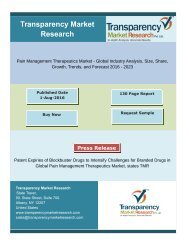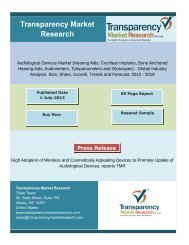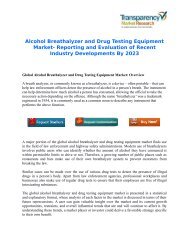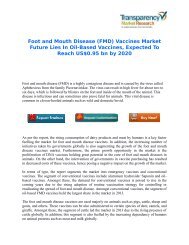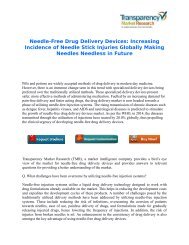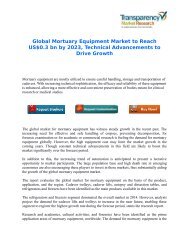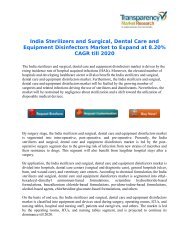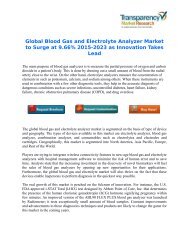Progressive Supranuclear Palsy (PSP) Market - Global Industry Analysis
Palsy is a class of neuro-degenerative disorders affecting many people worldwide. Frequently seen among the geriatric population, palsy is not necessarily endemic to older generation or a specific race, infact they have also been reported in much younger populations, although the reason may be different (trauma/abuse). Progressive supranuclear palsy is a type of palsy, specific to older populations, wherein certain sections of the brain die due to various, yet unknown reasons. The most plausible explanation for PSP found is the variation in the tau protein synthesis that leads to collapse of neurological cells in the brain.
Palsy is a class of neuro-degenerative disorders affecting many people worldwide. Frequently seen among the geriatric population, palsy is not necessarily endemic to older generation or a specific race, infact they have also been reported in much younger populations, although the reason may be different (trauma/abuse). Progressive supranuclear palsy is a type of palsy, specific to older populations, wherein certain sections of the brain die due to various, yet unknown reasons. The most plausible explanation for PSP found is the variation in the tau protein synthesis that leads to collapse of neurological cells in the brain.
You also want an ePaper? Increase the reach of your titles
YUMPU automatically turns print PDFs into web optimized ePapers that Google loves.
REPORT DESCRIPTION<br />
<strong>Palsy</strong> is a class of neuro-degenerative disorders affecting many people worldwide. Frequently seen among the geriatric population, palsy is not<br />
necessarily endemic to older generation or a specific race, infact they have also been reported in much younger populations, although the reason<br />
may be different (trauma/abuse). <strong>Progressive</strong> supranuclear palsy is a type of palsy, specific to older populations, wherein certain sections of the<br />
brain die due to various, yet unknown reasons. The most plausible explanation for <strong>PSP</strong> found is the variation in the tau protein synthesis that leads<br />
to collapse of neurological cells in the brain.<br />
The prominence of this factor has been studied in many patients, however it hasn’t been accepted as the primary cause for <strong>PSP</strong>, instead scientists<br />
believe tau protein variation may play an assisting role in <strong>PSP</strong>. The initial symptoms of <strong>PSP</strong> are similar to Parkinson’s disease, which involves<br />
frequent loss of balance, forward stoop, frequent collisions while walking, etc. Visual symptoms, i.e. nystagmus, inability to frequently close<br />
eyelids, difficult in focusing near objects, double vision and difficulty in moving eye in a vertical axis, are some of the primary symptoms that<br />
differentiate palsy from Parkinson’s disease. In the later stages a patient may exhibit behavioral changes, dementia, swallowing difficulties and<br />
speech slurring, to name a few.<br />
Browse Full Report With TOC:- http://www.transparencymarketresearch.com/progressive-supranuclear-palsy.html<br />
In extreme cases, paralysis and inability to move the neck is also reportedly seen. <strong>PSP</strong> is confirmed with an MRI of the brain, where brain clots or<br />
decay show affirmative signs. <strong>PSP</strong> diagnosed patients often have a window of 4-10 years, on an average 7 years until their death. The disorder<br />
has the prefix “<strong>Progressive</strong>” for the very same reason that <strong>PSP</strong> once diagnosed, is sure to result in total brain death for the patient in the near<br />
future.<br />
Treatments or cure for <strong>PSP</strong> do not exist as of date, symptomatic relief can however be provided to patients to ease their discomfort and pain.<br />
Treatment wise patients are segregated into levodopa responsive (in case Parkinsonism is accompanied with <strong>PSP</strong>) and levodopa unresponsive.<br />
Sometimes levodopa unresponsiveness is also used as a differentiating test for <strong>PSP</strong> from Parkinson’s, however a majority of medical practitioners<br />
believe both conditions can coexist in individuals. Migraine medications are given to ease headaches, which are frequent and cause much<br />
discomfort later on. OnabotulinumtoxinA is also administered as injections to ease dystonia and muscle rigidity. Methylcellulose eye drops are<br />
administered to patients with conjunctivitis, this is because <strong>PSP</strong> patients’ exhibit lower eyelid blink rate, thereby increasing their susceptibility to<br />
eye infection.







